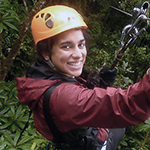A Chance Discovery Leads to Lifesaving Treatment
For Release: May 27, 2014
STANFORD, Calif. – In 2005, Monica Datta was just another 13-year-old in Palo Alto when she was intrigued by the idea of enrolling in a Stanford University clinical research study as a healthy comparison for researchers who were trying to understand more about depression. Looking back, that's when her life suddenly began its gradual turn upside down.
"I remember vividly the day everything changed," Datta said. "I was walking home from school, and I called my mom. She sounded like she'd been crying, and told me to come home." As with everyone who signed up for the study, Datta had to undergo an MRI. Unlike everyone else, hers had unexpectedly revealed a spot in her brain.
No symptoms
"I had no symptoms. It was hard to understand the gravity of the situation -- I felt fine," she said.

But how she felt and what that spot represented weren't necessarily the same. An appointment was quickly made with Paul Fisher, MD, professor of neurology at the Stanford School of Medicine, and director of the Brain and Behavior Center at Stanford University and Lucile Packard Children’s Hospital Stanford.
"We told her it could be a tumor, or it could be nothing,” Fisher said. “It’s very typical with this type of finding to watch and wait.”
As difficult as that can be for an anxious patient -- or anxious parent -- that's what Datta and her family did. As the lesion showed no signs of changing, her MRI scans over the years happened less and less frequently. The freshman became a high school senior, then a college student at UC-San Diego. Datta studied human biology and loved playing ultimate Frisbee, but she was decidedly not a brain tumor patient -- whatever had turned up on that scan years earlier had ceased to be a concern.
"By the time of her last appointment in September 2013, she'd graduated from college – she was 22. I was finally about to tell her she was in the clear," said Fisher, who is also the Beirne Family Professor of Pediatric Neuro-Oncology at the School of Medicine.
Datta underwent one last MRI at that final appointment, just to be sure, and she and Fisher said their goodbyes. But the next day Datta's phone rang. After nearly a decade without changing, her lesion had suddenly begun to grow, she was told.
"I was in shock," Datta said. "I'd felt entirely normal up to that point. I had a second scan in order to be certain."
That scan confirmed what she'd already feared: Brain surgery was needed. According to neurosurgeon Gerald Grant, MD, the lesion appeared to be a low-grade glioma. It was close to the area of the brain that controls the foot, so precise mapping of the surgery area would be imperative. A month after Datta got that call from Fisher, she came in for the procedure. Four hours later it was done.
Grant, associate professor of neurosurgery at the School of Medicine, told her it was a success, and the entirety of the tumor had been removed. Datta spent the next months recovering from the procedure -- a physically and emotionally grueling experience, but one over which she'd triumphed completely by early 2014.
"Looking back, it was bold and brave for the family to hear that there's something there, but to choose not to intervene. It was the right decision," Fisher said. "Oncology is built on the phrase 'early detection saves lives.' But there are times when you don't want to rush in. In this brave, new world, having better technology means you find more potentially problematic things, like Monica's lesion -- which can present tough questions for a patient. I think Monica and her parents are really admirable for how they handled this."
The UC-San Diego graduate will be taking the GRE this summer, and plans to pursue a master's in genetic counseling.
"It was such an emotional experience," Datta said. "But I feel really lucky to have gotten my care at Stanford."
Authors
Media contact:
Winter Johnson
Tel (650) 498-7056
wijohnson@stanfordchildrens.org
About Stanford Medicine Children's Health
Stanford Medicine Children’s Health, with Lucile Packard Children’s Hospital Stanford at its center, is the Bay Area’s largest health care system exclusively dedicated to children and expectant mothers. Our network of care includes more than 65 locations across Northern California and more than 85 locations in the U.S. Western region. Along with Stanford Health Care and the Stanford School of Medicine, we are part of Stanford Medicine, an ecosystem harnessing the potential of biomedicine through collaborative research, education, and clinical care to improve health outcomes around the world. We are a nonprofit organization committed to supporting the community through meaningful outreach programs and services and providing necessary medical care to families, regardless of their ability to pay. Discover more at stanfordchildrens.org.
Connect with us:
Download our App: